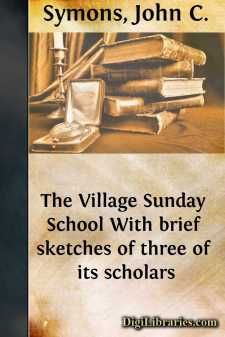Categories
- Antiques & Collectibles 13
- Architecture 36
- Art 48
- Bibles 22
- Biography & Autobiography 813
- Body, Mind & Spirit 142
- Business & Economics 28
- Children's Books 15
- Children's Fiction 12
- Computers 4
- Cooking 94
- Crafts & Hobbies 4
- Drama 346
- Education 46
- Family & Relationships 57
- Fiction 11828
- Games 19
- Gardening 17
- Health & Fitness 34
- History 1377
- House & Home 1
- Humor 147
- Juvenile Fiction 1873
- Juvenile Nonfiction 202
- Language Arts & Disciplines 88
- Law 16
- Literary Collections 686
- Literary Criticism 179
- Mathematics 13
- Medical 41
- Music 40
- Nature 179
- Non-Classifiable 1768
- Performing Arts 7
- Periodicals 1453
- Philosophy 64
- Photography 2
- Poetry 896
- Political Science 203
- Psychology 42
- Reference 154
- Religion 513
- Science 126
- Self-Help 84
- Social Science 81
- Sports & Recreation 34
- Study Aids 3
- Technology & Engineering 59
- Transportation 23
- Travel 463
- True Crime 29
The Village Sunday School With brief sketches of three of its scholars
by: John C. Symons
Categories:
Description:
Excerpt
CHAPTER I.
THE VILLAGE—THE NEW SUNDAY-SCHOOL—THE SUPERINTENDENT—A REVIVAL.
M—— is a small village in the west of England, delightfully situated in a wooded pleasant valley. Through it runs the parish road, which—as it leads to the seashore, from whence the farmers of that and the neighboring parishes bring great quantities of sand and seaweed as manure—frequently presents, in the summer, a bustling scene. The village is very scattered: on the right of the beautiful streamlet which flows silently down the valley, and runs across the road just in the centre of the village, stands an old mill; which for many a long year has been wont to throw out its murmuring sound, as the water falls over its broad and capacious wheel. On the other side of the stream, and just opposite the old mill, a few yards from the road, stands a neat, commodious, and well-built Methodist chapel, which, from the prominence of its situation, and good proportions, has often attracted the eye of the passing stranger.
It was about the period when my narrative commences that the chapel was built. For many years the Methodists had preached in the village, and there had been a small society under the care of an aged patriarch, whose gray hairs and tottering frame bespoke the near approach of the last enemy: soon he came, and suddenly removed that good man to "the palace of angels and God." In consequence of the preaching-place being far out of the way, and the place itself—an old barn—anything but inviting, there had been for many years but little success.
In 18—, two or three zealous brethren from another part of the circuit settled in the vicinity of M——, and steps were at once taken to get a favorable site, and to raise subscriptions towards building a chapel as speedily as possible. The neighboring "squire" was waited upon by two of the new members, with whom he was personally acquainted; when, without hesitation, he gave them the spot of ground on which the chapel now stands. The chapel was soon built, and opened for divine worship; and many of the old members, who had witnessed the introduction of Methodism into the village, were constrained to exclaim, "What hath God wrought!"
The village, though small, was surrounded by a populous neighborhood, and many of the friends were anxious for the establishment of a Sabbath-school. In this they had many difficulties to contend with; arising principally from the awful carelessness of parents about their children's spiritual welfare, and the want of adequate help to carry on a school. However, they determined to make an attempt: and, accordingly, at no great period after the new chapel was erected, a school was established. As the society was small, pious teachers could not be secured, and they were under the necessity of employing persons of good moral character, or of abandoning the school altogether.
Few, perhaps, are more sensible of the advantage of pious teachers, than myself: and, whenever it is possible, I would have no others in a school....


